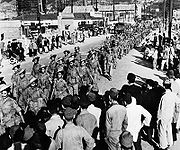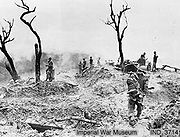
Nepal during World War II
Encyclopedia
Following the invasion of Poland, Nepal declared war on Germany on September 4th, 1939. Subsequently, sixteen battalions of the Royal Nepalese Army fought Japan on the Burmese front. In addition to military support, Nepal contributed guns, equipment as well as hundreds of thousand of pounds of tea, sugar and raw materials such as timber to the allied war effort.
During World War II
, There was an internal treaty between Nepal
and Britain
about the mobilization of Nepalese soldiers. In addition to RNA troops, Nepalese fought in the British Gorkha units and were engaged in combat all over the world. Gorkha troops were part of the allied occupation force in Japan.
 The Nepali units which took part were Sri Nath, Kalibox, Surya Dal, Naya Gorakh, Barda Bahadur, Kali
The Nepali units which took part were Sri Nath, Kalibox, Surya Dal, Naya Gorakh, Barda Bahadur, Kali
Bahadur, Mahindra Dal, Second Rifle, Bhairung, Jabbar Jung, Shumsher Dal, Sher, Devi Dutta, Bhairab Nath, Jagannath and Purano Gorakh Battalions. Besides, there were many high ranking Nepalese in the joint Army HQ. Commander-in–Chief Kiran Shumsher Rana and Field Marshall Nir Shumsher Rana were liaison officers from the Royal Nepalese Army.
 When Japan
When Japan
got involved in this war in December 1940, the British presence was threatened in the Indian subcontinent
. Britain deployed its troops in India and on the Burma front. Nepalese battalions – Mahindra Dal, Sher, Kali Bahadur and Jagannath- were also deployed. These Nepalese battalions fought under the Allied Command. The Jagannath Battalion took part as engineers
to construct tracks, bridges, water points etc.
Nepalese troops fought with distinction in the British 14th Army under Lieutenant General William Slim
and helped force the eventual Japanese retreat. Finally, following the atomic bomb attacks on Hiroshima and Nagasaki, Japan surrendered. Most Nepalese troops were withdrawn to Kathmandu in Oct 1945. A grand victory parade was held on 28 October 1945 where many Nepalese soldiers, officers and associated British officers were honored for their appreciable performances.
During World War II
World War II
World War II, or the Second World War , was a global conflict lasting from 1939 to 1945, involving most of the world's nations—including all of the great powers—eventually forming two opposing military alliances: the Allies and the Axis...
, There was an internal treaty between Nepal
Nepal
Nepal , officially the Federal Democratic Republic of Nepal, is a landlocked sovereign state located in South Asia. It is located in the Himalayas and bordered to the north by the People's Republic of China, and to the south, east, and west by the Republic of India...
and Britain
United Kingdom
The United Kingdom of Great Britain and Northern IrelandIn the United Kingdom and Dependencies, other languages have been officially recognised as legitimate autochthonous languages under the European Charter for Regional or Minority Languages...
about the mobilization of Nepalese soldiers. In addition to RNA troops, Nepalese fought in the British Gorkha units and were engaged in combat all over the world. Gorkha troops were part of the allied occupation force in Japan.


Bahadur, Mahindra Dal, Second Rifle, Bhairung, Jabbar Jung, Shumsher Dal, Sher, Devi Dutta, Bhairab Nath, Jagannath and Purano Gorakh Battalions. Besides, there were many high ranking Nepalese in the joint Army HQ. Commander-in–Chief Kiran Shumsher Rana and Field Marshall Nir Shumsher Rana were liaison officers from the Royal Nepalese Army.

Japan
Japan is an island nation in East Asia. Located in the Pacific Ocean, it lies to the east of the Sea of Japan, China, North Korea, South Korea and Russia, stretching from the Sea of Okhotsk in the north to the East China Sea and Taiwan in the south...
got involved in this war in December 1940, the British presence was threatened in the Indian subcontinent
Indian subcontinent
The Indian subcontinent, also Indian Subcontinent, Indo-Pak Subcontinent or South Asian Subcontinent is a region of the Asian continent on the Indian tectonic plate from the Hindu Kush or Hindu Koh, Himalayas and including the Kuen Lun and Karakoram ranges, forming a land mass which extends...
. Britain deployed its troops in India and on the Burma front. Nepalese battalions – Mahindra Dal, Sher, Kali Bahadur and Jagannath- were also deployed. These Nepalese battalions fought under the Allied Command. The Jagannath Battalion took part as engineers
to construct tracks, bridges, water points etc.
Nepalese troops fought with distinction in the British 14th Army under Lieutenant General William Slim
William Slim, 1st Viscount Slim
Field Marshal William Joseph "Bill"'Slim, 1st Viscount Slim, KG, GCB, GCMG, GCVO, GBE, DSO, MC, KStJ was a British military commander and the 13th Governor-General of Australia....
and helped force the eventual Japanese retreat. Finally, following the atomic bomb attacks on Hiroshima and Nagasaki, Japan surrendered. Most Nepalese troops were withdrawn to Kathmandu in Oct 1945. A grand victory parade was held on 28 October 1945 where many Nepalese soldiers, officers and associated British officers were honored for their appreciable performances.

